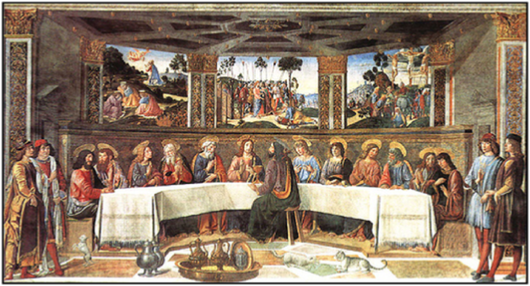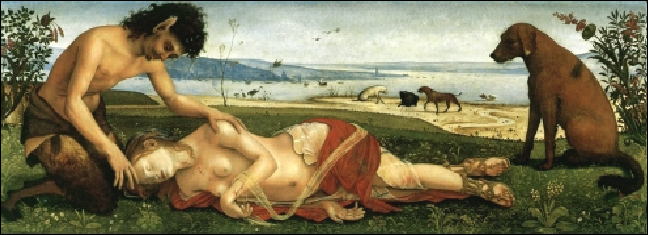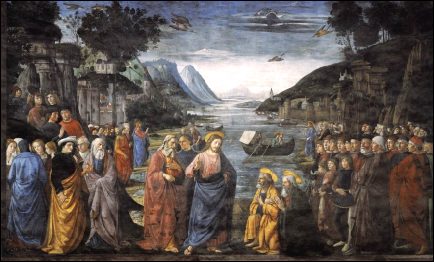


THE SISTINE CHAPEL -
xxxxxThe  building of the Sistine Chapel in the Vatican Palace in Rome, was begun in 1473 by the Italian architect Giovanni dei Dolci, and completed in 1481 for the then Pope, Sixtus IV -
building of the Sistine Chapel in the Vatican Palace in Rome, was begun in 1473 by the Italian architect Giovanni dei Dolci, and completed in 1481 for the then Pope, Sixtus IV -
xxxxxRectangular in shape and with six arched windows along the two main sides, the interior walls and barrel-
xxxxxAs we shall see (H7), the two giants of the Italian Renaissance, Michelangelo and Raphael, were to add immeasurably to the beauty of the Sistine Chapel, and in this great upsurge of artistic talent, the genius of Leonardo da Vinci was yet to come to full fruition.
xxxxxIncidentally, when a new Pope is being voted into office, people waiting in St. Peter's square soon know when one has been appointed. The cardinals vote by secret ballot twice a day, and after each vote the papers are burned in the chapel's stove and the smoke from the fire passes up a pipe and can be seen outside. When none of the candidates receives the required majority, the votes are burned using wet straw, so the smoke is black. When a pope is elected, the votes are burned with dry straw and the smoke is seen to be white.
 xxxxxThe Florentine painter Piero di Cosimo (1462-
xxxxxThe Florentine painter Piero di Cosimo (1462-
xxxxxA recluse and an eccentric, much of his work is characterised by strange shaped human figures and animals, and his lively imagination made him particularly skilful at producing designs for festivals and masques. He painted, it would seem, for his own pleasure, and is reported to have claimed that he could well gain inspiration for his work from the stains on a wall! It is also said that during his life time he eat nothing but hard-

xxxxxThe building of the Sistine Chapel was begun in 1473 and completed in 1481. Having the same proportions as those of Solomon's temple, it was built as the pope's private chapel and for the election of a new pope when a vacancy occurred. The side walls are painted with 14 magnificent scenes depicting the life of Christ and Moses. Among the artists honoured for this work were Botticelli, Perugino, Pintoricchio, Cosimo Rosselli, Piero di Cosimo, and Ghirlandaio. Later, as we shall see (H7), contributions were to come from two giants of the Italian Renaissance, Michelangelo and Raphael.
Including:
Piero di Cosimo
and
Domenico Ghirlandaio

xxxxxAnother artist who worked on the Sistine frescoes was Domenico Ghirlandaio (1449-
 xxxxxGhirlandaio went on to produce a large number of decorative narratives for family chapels in Florence. Notable are the six large frescoes depicting scenes from the life of Saint Francis in the church of Santa Trinita (three illustrated below), and the series painted for the Medici banker Giovanni Tornabuoni showing episodes from the life of the Virgin Mary and John the Baptist. He was also a competent portrait painter, noted for his lovely portrait of the beautiful young Giovanna Tornabuoni. But perhaps his fame rests mainly on the fact that Michelangelo trained for a while in his workshop. It is said that the talented youngster was due to spend three years as an apprentice but left after a year, having nothing more to learn!
xxxxxGhirlandaio went on to produce a large number of decorative narratives for family chapels in Florence. Notable are the six large frescoes depicting scenes from the life of Saint Francis in the church of Santa Trinita (three illustrated below), and the series painted for the Medici banker Giovanni Tornabuoni showing episodes from the life of the Virgin Mary and John the Baptist. He was also a competent portrait painter, noted for his lovely portrait of the beautiful young Giovanna Tornabuoni. But perhaps his fame rests mainly on the fact that Michelangelo trained for a while in his workshop. It is said that the talented youngster was due to spend three years as an apprentice but left after a year, having nothing more to learn!
xxxxxApart from his fresco in the Sistine Chapel representing the calling of Peter and Andrew, the Florentine artist Domenico Ghirlandaio (1449-
xxxxxIncidentally, Ghirlandaio derived his name from the fact that his father, a goldsmith, was particularly good at making silver wreaths for ladies' head-
Left to Right : The Renunciation of Worldly Goods, The Stigmata of St. Francis, and The Death of St. Francis



Acknowledgements
Piero: Last Supper (together with Rosselli di Cosimo) – Fresco, Sistine Chapel, Vatican, Rome; Satyr mourning over a Nymph – National Gallery, London; The Forest Fire – The Ashmolean Museum, Oxford; The Immaculate Conception – Uffizi Gallery, Florence; Ghirlandaio: The Calling of Peter and Andrew -
E4-
